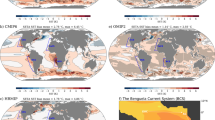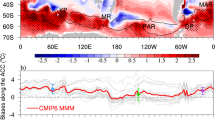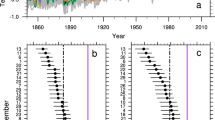Abstract
The Intergovernmental Panel on Climate Change’s Fifth Assessment Report largely depends on simulations, predictions and projections by climate models1. Most models, however, have deficiencies and biases that raise large uncertainties in their products. Over the past several decades, a tremendous effort has been made to improve model performance in the simulation of special regions and aspects of the climate system2,3,4. Here we show that biases or errors in special regions can be linked with others at far away locations. We find in 22 climate models that regional sea surface temperature (SST) biases are commonly linked with the Atlantic meridional overturning circulation (AMOC), which is characterized by the northward flow in the upper ocean and returning southward flow in the deep ocean. A simulated weak AMOC is associated with cold biases in the entire Northern Hemisphere with an atmospheric pattern that resembles the Northern Hemisphere annular mode. The AMOC weakening is also associated with a strengthening of Antarctic Bottom Water formation and warm SST biases in the Southern Ocean. It is also shown that cold biases in the tropical North Atlantic and West African/Indian monsoon regions during the warm season in the Northern Hemisphere have interhemispheric links with warm SST biases in the tropical southeastern Pacific and Atlantic, respectively. The results suggest that improving the simulation of regional processes may not suffice for overall better model performance, as the effects of remote biases may override them.
This is a preview of subscription content, access via your institution
Access options
Subscribe to this journal
Receive 12 print issues and online access
$209.00 per year
only $17.42 per issue
Buy this article
- Purchase on Springer Link
- Instant access to full article PDF
Prices may be subject to local taxes which are calculated during checkout




Similar content being viewed by others
References
Taylor, K. E., Stouffer, R. J. & Meehl, G. A. An overview of CMIP5 and the experiment design. Bull. Amer. Meteor. Soc. 93, 485–498 (2012).
Li, G. & Xie, S.-P. Origins of tropical-wide SST biases in CMIP multi-model ensembles. Geophys. Res. Lett 39, L22703 (2012).
Guilyardi, E. et al. Understanding El Niño in ocean-atmosphere general circulation models: Progress and challenges. Bull. Amer. Met. Soc. 90, 325–340 (2009).
Collins, M. et al. The impact of global warming on the tropical Pacific and El Niño. Nature Geosci. 3, 391–397 (2010).
Mechoso, C. R. et al. Ocean-cloud-atmosphere-land interactions in the Southeastern Pacific: The VOCALS Program. Bull. Am. Met. Soc. (in the press, 2013).
Mechoso, C. R. et al. The seasonal cycle over the tropical Pacific in general circulation models. Mon. Weath. Rev 123, 2825–2838 (1995).
Huang, B., Hu, Z.-Z. & Jha, B. Evolution of model systematic errors in the tropical Atlantic basin from the NCEP coupled hindcasts. Clim. Dynam. 28, 661–682 (2007).
Colas, F., McWilliams, J. C., Capet, X. & Jaison, K. Heat balance and eddies in the Peru–Chile current system. Clim. Dynam. 39, 509–529 (2012).
Davey, M. K. et al. STOIC: a study of coupled model climatology and variability in tropical ocean regions. Clim. Dynam. 18, 403–420 (2002).
Hwang, Y.-T. & Frierson, D. M. W. Link between the double-Intertropical Convergence Zone problem and cloud biases over the Southern Ocean. Proc. Natl Acad. Sci. USA 10.1073/pnas.1213302110PNAS (2013).
Wunsch, C. & Heimbach, P. Estimated decadal changes in the North Atlantic meridional overturning circulation and heat flux 1993 2004. J. Phys. Oceanogr. 36, 2012–2024 (2006).
Zhang, R. Coherent surface-subsurface fingerprint of the Atlantic meridional overturning circulation. Geophys. Res. Lett. 35, L20705 (2008).
Knight, J. R., Allan, R. J., Folland, C. K., Vellinga, M. & Mann, M. E. A signature of persistent natural thermohaline circulation cycles in observed climate. Geophys. Res. Lett 32, L20708 (2005).
Folland, C. K., Parker, D. E. & Palmer, T. N. Sahel rainfall and worldwide sea temperatures, 1901–85. Nature 320, 602–607 (1986).
Delworth, T. L. & Mann, M. E. Observed and simulated multidecadal variability in the Northern Hemisphere. Clim. Dynam. 16, 661–676 (2000).
Zhang, R., Delworth, T. L. & Held, I. Can the Atlantic Ocean drive the observed multidecadal variability in Northern Hemisphere mean temperature?. Geophys. Res. Lett 34, L02709 (2007).
Stouffer, R. et al. Investigating the causes of the response of the thermohaline circulation to past and future climate changes. J. Clim. 19, 1365–1387 (2006).
Wu, L., Li, C., Yang, C. & Xie, S.-P. Global teleconnections in response to a shutdown of the Atlantic meridional overturning circulation. J. Clim. 21, 3002–3019 (2008).
Thompson, D. W. & Wallace, J. M. Annular modes in the extratropical circulation. Part I: Month-to-month variability. J. Clim. 13, 1000–1016 (2000).
Zhang, R. & Delworth, T. L. Impact of the Atlantic Multidecadal Oscillation on North Pacific climate variability. Geophys. Res. Lett. 34, L23708 (2007).
Meehl, G. A., Hu, A., Arblaster, J., Fasullo, J. & Trenberth, K. E. Externally forced and internally generated decadal climate variability associated with the Interdecadal Pacific Oscillation. J. Clim. 26, 7298–7310 (2013).
Zhang, R. et al. Sensitivity of the North Atlantic Ocean circulation to an abrupt change in the Nordic Sea overflow in a high resolution global coupled climate model. J. Geophys. Res. 116, C12024 (2011).
Broecker, W. S. Paleocean circulation during the last deglaciation: a bipolar seesaw?. Paleoceanography 13, 119–121 (1998).
Weaver, A. J., Saenko, O. A., Clark, P. U. & Mitrovica, J. X. Meltwater pulse 1A from Antarctic as a trigger of the Bølling-Allerød warm interval. Science 299, 1709–1713 (2003).
Ma, H. & Wu, L. Global teleconnections in response to freshening over the Antarctic Ocean. J. Clim. 24, 1071–1088 (2011).
Kang, S. M., Held, I. M. & Xie, S.-P. Contrasting the tropical response to zonally asymmetric extratropical and tropical thermal forcing. Clim. Dynam. 10.1007/s00382-013-1863-0 (2013).
Wang, C., Enfield, D. B., Lee, S.-K. & Landsea, C. W. Influences of the Atlantic warm pool on Western Hemisphere summer rainfall and Atlantic hurricanes. J. Clim. 19, 3011–3028 (2006).
Wang, C., Lee, S.-K. & Mechoso, C. R. Inter-hemispheric influence of the Atlantic warm pool on the southeastern Pacific. J. Clim. 23, 404–418 (2010).
Richter, I., Mechoso, C. R. & Robertson, A. W. What determines the position and intensity of the South Atlantic anticyclone in austral winter?—An AGCM study. J. Clim. 21, 214–229 (2008).
Yeager, S. & Danabasoglu, G. Sensitivity of Atlantic meridional overturning circulation variability to parameterized Nordic Sea overflows in CCSM4. J. Clim. 25, 2077–2103 (2012).
Acknowledgements
R. Lumpkin served as an internal reviewer of the Atlantic Oceanographic and Meteorological Laboratory (AOML). This work was supported by grants from the National Oceanic and Atmospheric Administration (NOAA) Climate Program Office, National Science Foundation, the base funding of NOAA/AOML, China National Global Change Major Research Project (2013CB956201), and China National Science Foundation Key Project (41130859). The findings and conclusions in this report are those of the author(s) and do not necessarily represent the views of the funding agency.
Author information
Authors and Affiliations
Contributions
C.W. and L.Z. designed the study. L.Z. made all plots and analyses. C.W. wrote the paper and C.R.M. contributed significantly to the text. All co-authors helped interpret the analyses and also edited the paper.
Corresponding authors
Ethics declarations
Competing interests
The authors declare no competing financial interests.
Supplementary information
Rights and permissions
About this article
Cite this article
Wang, C., Zhang, L., Lee, SK. et al. A global perspective on CMIP5 climate model biases. Nature Clim Change 4, 201–205 (2014). https://doi.org/10.1038/nclimate2118
Received:
Accepted:
Published:
Issue Date:
DOI: https://doi.org/10.1038/nclimate2118
This article is cited by
-
Significantly wetter or drier future conditions for one to two thirds of the world’s population
Nature Communications (2024)
-
Numerical simulations of Atlantic meridional overturning circulation (AMOC) from OMIP experiments and its sensitivity to surface forcing
Journal of Oceanology and Limnology (2024)
-
Attribution of Biases of Interhemispheric Temperature Contrast in CMIP6 Models
Advances in Atmospheric Sciences (2024)
-
Origins of Southern Ocean warm sea surface temperature bias in CMIP6 models
npj Climate and Atmospheric Science (2023)
-
Impacts of the North Atlantic biases on the upper troposphere/lower stratosphere over the extratropical North Pacific
npj Climate and Atmospheric Science (2023)



